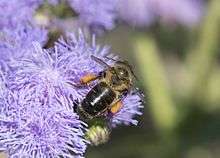Caucasian honey bee
| Caucasian bee | |
|---|---|
 | |
| Scientific classification | |
| Kingdom: | Animalia |
| Phylum: | Arthropoda |
| Class: | Insecta |
| Order: | Hymenoptera |
| Suborder: | Apocrita |
| Family: | Apidae |
| Subfamily: | Apinae |
| Tribe: | Apini |
| Genus: | Apis |
| Species: | A. mellifera |
| Subspecies: | A. m. caucasia |
| Trinomial name | |
| Apis mellifera caucasia Pollmann, 1889 | |
| Synonyms | |
| |
The Caucasian honey bee (Apis mellifera caucasia, commonly misspelled caucasica[1]) is a sub-species of the Western honey bee.
Origin
The Caucasian honey bee originates from the high valleys of the Central Caucasus. Georgia is the “central homeland” for the subspecies, although the bees also can be found in eastern Turkey, Armenia and Azerbaijan.[2]
Anatomy and Appearance
- Shape and Size: similar to A. m. carnica
- Chitin Color: dark with brown spots at times
- Hair Color: lead-grey
- Tongue Length: up to 7.2 mm
Behavior
beneficial for beekeeping
- gentle and calm on the comb
- ardent brood production - raising strong colonies
- colonies reach full strength in mid-summer, which is good for areas where the highest nectar flow is in mid-summer
- very great user of propolis
- in its native area a better honey producer than the European dark bee
not beneficial for beekeeping
- colonies do not reach full strength until mid-summer, which is an undesirable trait for areas with the highest nectar flow in the spring.
- the great use of propolis may be seen as undesirable as it makes hive management more difficult. Frames and hive boxes are glued together more substantially.
- over wintering in northern climates not good due to susceptibility to nosema
- inclined to drifting and robbing
Sources
The Hive and the honeybee, Chapter 11 Races of bees by Prof. Friedrich Ruttner, published by Dadant 1975
This article is issued from Wikipedia - version of the 11/16/2016. The text is available under the Creative Commons Attribution/Share Alike but additional terms may apply for the media files.